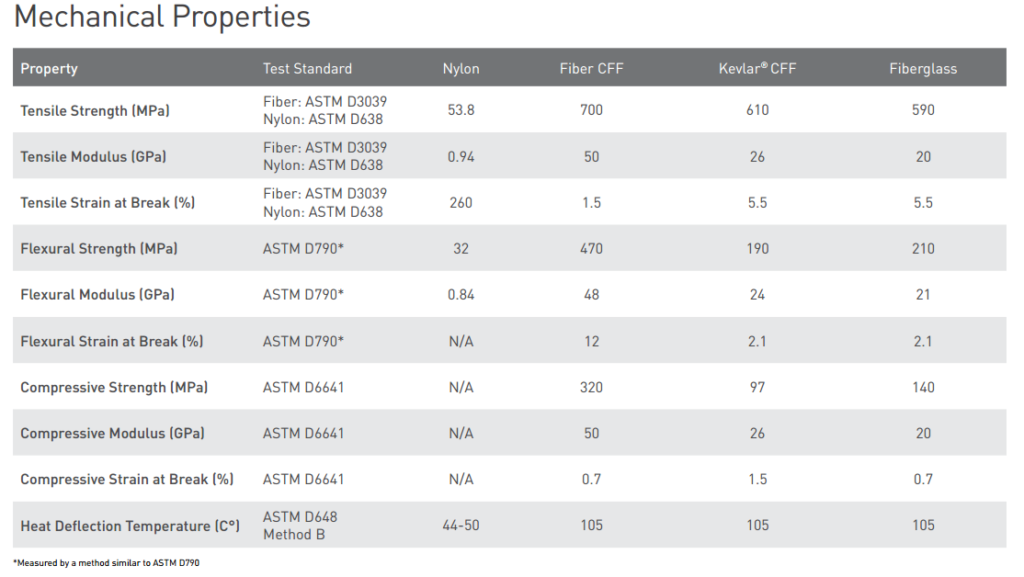Fiber-Reinforced Nylon: 3D Hubs Releases Kevlar, Carbon & Fiberglass Materials for Strong Yet Affordable 3D Printing
 If you enjoy 3D printing, chances are you’ve also gained quite an appreciation for the science—and wide range of choices—of materials that now accompany this technology. Most likely you began printing with ABS and/or PLA, starting off with an elementary understanding of the materials you could feed into your machine. Then, as curiosity and creativity motivated you to explore further, you may have even branched out into using some of the more alternative materials—many of which we enjoy seeing designers try out like bamboo, ceramics, sandstone, and the list goes on, often offering quite noteworthy results. It’s easy to stick with the basics, but often project requirements force us to take that extra step and try something newer and stronger.
If you enjoy 3D printing, chances are you’ve also gained quite an appreciation for the science—and wide range of choices—of materials that now accompany this technology. Most likely you began printing with ABS and/or PLA, starting off with an elementary understanding of the materials you could feed into your machine. Then, as curiosity and creativity motivated you to explore further, you may have even branched out into using some of the more alternative materials—many of which we enjoy seeing designers try out like bamboo, ceramics, sandstone, and the list goes on, often offering quite noteworthy results. It’s easy to stick with the basics, but often project requirements force us to take that extra step and try something newer and stronger.
It’s in more ways than one that companies like 3D Hubs help you make that jump. Not only do they provide helpful monthly trends and yearly reports regarding industry data, but they also have a network of nearly 30,000 hubs around the world providing local printing services to makers around the world, whether they be hobbyists, professionals, or those in need of industrial 3D printers. Now they’ll be making their mark further—and helping you to make one too—as they become the first 3D print service to offer Kevlar-, fiberglass- and carbon-reinforced nylons.
As 3D printing with metals and reinforced plastics has become the go-to for industrial printing, many others have hoped to venture into using the material too, but it’s been cost-prohibitive, with the equipment simply out of reach also—not previously part of that ‘affordability and accessibility for all’ campaign, apparently. The benefit with these new fiber-reinforced nylons from 3D Hubs is that now they do allow you to print affordably with plastic while enjoying the strength benefits of metals, and should prove attractive in the engineering sector for printing objects like jigs, fixtures, and tooling. This material can even be used to print moving or interlocking parts in just one go.
3D Hubs is launching the new materials in partnership with one of the most experienced and innovative manufacturers in the business by way of MarkForged, a company we’ve been following since the inception of their flagship Mark One 3D printer, famous for its capability in extruding continuous carbon fiber. Now, the Mark Two will be designated for using these new materials to print models for 3D Hubs customers as they seek strength and can benefit from plastics that are much more affordable (and as an example, to price a product with carbon, see here). The Mark Two is an industrial-strength printer that will be able to continuously print the carbon, Kevlar, and fiberglass materials using both their continuous filament fabrication (CFF) printhead and an FFF printhead.
“Adding fibres during the 3D printing process is complex and needs an expert operator running the machine,” states 3D Hubs in a recent press release. “Through our network of nearby 3D printing service providers we’re able to deliver this expertise for each project, making this technology accessible for all professionals.”

Brake levers 3D printed using a full range of 3D Hubs’ new materials, from left to right, nylon, fiberglass, kevlar, carbon, full carbon
Below are features of each material, with a spec sheet for all following this article:
- Carbon-reinforced nylon – offers higher strength-to-weight than 6061 aluminum, and is up to 27 times stiffer and 24 times stronger than ABS.
- Kevlar-reinforced nylon – has the best abrasion resistance and is the most flexible fiber-reinforced nylon material. This material is recommended when you need parts that are durable and resistant to impact.
- Fiberglass-reinforced nylon – cost effective, and as strong as carbon fiber, this material is 60% less stiff, and two times heavier. 3D hubs recommends it for everyday applications where you need strong parts.
3D Hubs states that the materials are ‘less suitable’ for small, detailed parts, but great for making functional prototypes, custom end-use production parts, and structural parts.
Some important design tips when using these materials are:
- Not recommended for smaller, intricate parts.
- A minimum detail size of 0.8 mm is required.
- A minimum feature size 3mm is required (this allows the fiber to be laid down between the layers of the shell).
- For printing with moving and interlocking parts, keep in mind that a .5mm clearance is required for parts to come loose.
- Angles greater than 40 degrees usually need supports.
- The minimum wall thickness is 3mm.
3D Hubs currently has 17 certified providers around the world, to include Europe, the US, and Oceania—all of whom will be shipping the new fiber-reinforced nylon prints to customers. See 3D Hubs for more details on these materials and further examples of prints. Are you interested in these metal-like printing materials? Discuss over in the 3D Hubs Lineup of New 3D Printing Materials forum over at 3DPB.com.
[Images: 3D Hubs]Subscribe to Our Email Newsletter
Stay up-to-date on all the latest news from the 3D printing industry and receive information and offers from third party vendors.
You May Also Like
3D Printing News Briefs, April 13, 2024: Robotics, Orthotics, & Hypersonics
In 3D Printing News Briefs today, we’re focusing first on robotics, as Carnegie Mellon University’s new Robotics Innovation Center will house several community outreach programs, and Ugogo3D is now working...
Rail Giant Alstom Saves $15M with 3D Printing Automation Software 3D Spark
3D Spark has entered into a three-year deal with the rail giant Alstom. Alstom, a transport behemoth with annual revenues of $16 billion, specializes in the manufacture of trains, trams,...
Meltio Expands Global Reach with New Partnerships in the Americas and Europe
Spanish 3D printing manufacturer Meltio has expanded its sales network across the globe. With the addition of three new partners in the United States, Brazil, Argentina, and Italy, Meltio aims...
3D Printing Webinar and Event Roundup: April 7, 2024
Webinars and events in the 3D printing industry are picking back up this week! Sea-Air-Space is coming to Maryland, and SAE International is sponsoring a 3D Systems webinar about 3D...


































